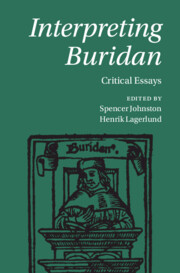Book contents
- Interpreting Buridan
- Interpreting Buridan
- Copyright page
- Dedication
- Contents
- Contributors
- Preface
- Abbreviations
- Introduction
- 1 The Philosopher as Arts Master
- 2 Principles in Buridan’s Logic of Consequences
- 3 Buridan on Paradox
- 4 Modality and Temporality in Buridan’s Logic
- 5 A Paradigm Change within Medieval Philosophy
- 6 Buridan’s Internalism
- 7 John Buridan on the Ontological Status of Artifacts
- 8 John Buridan on Final Causality
- 9 Female Physiology in John Buridan’s Quaestiones de secretis mulierum
- 10 Buridan on the Value of Emotions
- 11 Buridan on Happiness and the Good Life
- References
- Index
- References
1 - The Philosopher as Arts Master
Buridan’s Career at the University of Paris
Published online by Cambridge University Press: 01 February 2024
- Interpreting Buridan
- Interpreting Buridan
- Copyright page
- Dedication
- Contents
- Contributors
- Preface
- Abbreviations
- Introduction
- 1 The Philosopher as Arts Master
- 2 Principles in Buridan’s Logic of Consequences
- 3 Buridan on Paradox
- 4 Modality and Temporality in Buridan’s Logic
- 5 A Paradigm Change within Medieval Philosophy
- 6 Buridan’s Internalism
- 7 John Buridan on the Ontological Status of Artifacts
- 8 John Buridan on Final Causality
- 9 Female Physiology in John Buridan’s Quaestiones de secretis mulierum
- 10 Buridan on the Value of Emotions
- 11 Buridan on Happiness and the Good Life
- References
- Index
- References
Summary
How was Buridan’s thought shaped by its institutional setting and by pedagogical practice in the faculty of arts at the University of Paris? This essay argues that local circumstances are crucial not only for interpreting Buridan’s arguments, but also for understanding his larger contribution to the history of philosophy. Thus, we find that even working within the constraints of the arts curriculum, Buridan was always able to segue from established modes of instruction and prescribed topics to discuss philosophical problems of interest to him; in this he was no different from other arts masters of the period, and indeed, from university lecturers even today. But he also used his independence to embody, in ways he himself may not have fully understood, a new way of being a philosopher. Whereas a century earlier, Thomas Aquinas saw himself as a theologian and regarded philosophy as an activity proper to pagans such as Plato and Aristotle, Buridan sought to define what he was doing in contradistinction to theology, and on grounds we would now recognize as secular.
Keywords
Information
- Type
- Chapter
- Information
- Interpreting BuridanCritical Essays, pp. 7 - 21Publisher: Cambridge University PressPrint publication year: 2024
